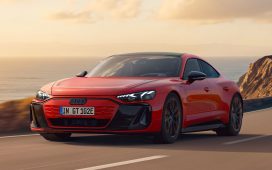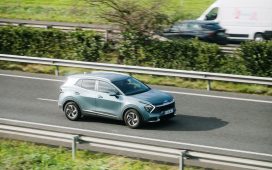Electromobility Research
After a prolonged period of accelerated growth, the electric car market appears to be slowing down. Sales growth rates are decreasing, as shown by statistics in a multitude of countries worldwide, except China, which is a world of its own.
This fact has already been confirmed by research from leading companies such as McKinsey & Co., among others, with the International Energy Agency still insisting that the decarbonization targets for 2035 and 2050, directly linked to the prospect of vehicle electrification, will be achieved and will not deviate.
However, the slowdown in sales growth is already impacting the results of major automakers who have invested in electromobility, forcing them to adjust their plans to maintain profitability. Of course, overall car production isn’t decreasing; only their distribution by engine type is changing. Even the most calm market assessments indicate that the slowdown in the electrification boom will not be long-term but temporary. This development is inevitable and irreversible.

Moreover, the phrase “once you go electric, you never go back” still holds, with the overwhelming majority of drivers who chose electric vehicles not abandoning their choice. Greece, for example, like other countries, is an example of a market where electromobility continues to gain momentum and is not faltering.
The Data
However, significant issues need to be resolved to clarify the landscape and for the upward sales trend to return stronger. Firstly, those highlighted by everyday life do not even require research: the high purchase cost and the seamless charging capability of vehicles.
“Houston, we have a problem.” This borrowed phrase from the dialogues of astronauts with NASA’s control center was the first comment among hundreds that followed on the popular American website Ridgewood, regarding the publication of McKinsey & Co.’s research conclusions on the future of vehicle electrification.
Research that was recently made public, caused a sensation in the international market, industries, consumers, and governments alike. Reflecting a reality many saw forming but hesitated to admit.
From McKinsey’s 2024 Mobility Consumer Pulse, released at the end of July, it emerges that 46% of electric vehicle (EV) owners in the USA consider it “very likely” to return to owning an internal combustion engine (ICE) vehicle in their next purchase.


This high percentage surprised even the consulting firm itself. “I didn’t expect this, as I thought ‘once an EV buyer, always an EV buyer,’” commented Philipp Kampshoff, head of McKinsey’s Center for Future Mobility.
The research, based on a sample of 37,000 consumers worldwide, found Australia leading globally, with one in two electric vehicle owners ready to return to an ICE vehicle. Other countries included in the research were the USA, Brazil, China, France, Germany, Italy, Japan, Norway, and others, totaling 15 countries covering 80% of the global electric vehicle market. The average percentage of respondents wanting to abandon their electric vehicle is a significant 29%.
Moreover, McKinsey’s data is supported by a study from the car market research platform Edmunds, owned by Carmax, which found that in the second quarter of this year, 39.4% of electric vehicles traded in were used to buy or lease a new ICE vehicle.
Another recent Gallup poll also converges in this direction: the number of consumers in the USA planning to buy an electric car decreased from 43% in 2023 to 35% this year.
Charging Infrastructure
The primary concern to be addressed is the reasons causing consumers’ changing attitudes towards electromobility.
At the top is the inadequate charging infrastructure and the continuous anxiety of drivers about their vehicle’s range. According to the research, 35% of electric car drivers considering switching to an ICE vehicle cite the lack of sufficient public charging infrastructure as a major reason, while 21% say they can no longer tolerate the stress related to accessing a charging point. This problem is perceived everywhere, even in the most advanced electromobility countries.
McKinsey found that consumer satisfaction globally with charging availability has improved compared to last year’s survey, but noted that “there is still a long way to go.” Only 11% of electric vehicle owners said the charging infrastructure in their area is satisfactory. 40% reported a lack of chargers along highways and main roads, and 38% said there aren’t any nearby.
A significant boost to electromobility is expected from the “Move Electric 3” program, which advances with the “first come, first served” process and immediate payment, with amounts up to 11,000 euros, as the scrapping incentive has been doubled to 2,000 euros.
Purchase Cost
Closely following is the financial burden on consumers. And this is probably the main reason, as it concerns the real deterrent for new buyers to enter the world of electromobility. Although citizens’ ecological sensitivities worldwide have intensified, experiencing first-hand the dramatic consequences of climate change, which mobilizes them towards adopting environmentally friendly behaviors, a crucial criterion for their new car purchase remains economic.
The high cost of purchasing an electric car, despite falling prices and various subsidies depending on the country, is equally a strong reason for returning to an ICE vehicle among EV buyers, with 34% of EV drivers stating that “the overall cost of driving is too high.”
This is directly linked to the third reason, which is the noticeable drop in resale value. The pressure on electric car sales forced automakers to reduce their prices and offer more incentives – lower interest rates and better leasing terms than ICE cars. However, it also led to a sharp decline in the value of used electric vehicles, proportional to the resale price drop of conventional cars.
Finally, there is a fourth finding concerning the low satisfaction rate of those using electric cars as their primary means of transportation. These are middle-income EV users, who typically don’t have their own charging system and experience daily stress about their vehicle’s range, charging time, and convenience.
In contrast, high-income users report being very satisfied with their electric vehicle, as they generally have their storage and charging facilities, hence they state that they are likely to replace it with another EV.
Pressure on the Industry
According to Ridgewood, the reasons above create serious reservations among potential new electric car buyers and cause the so-called “buyer’s remorse” among current users.
In market terms, this situation strongly pressures automakers’ results. For example, Elon Musk’s Tesla reported better-than-expected deliveries for the second quarter of this year, but still decreased compared to a year earlier for the second consecutive period, leading to a 7% revenue decline. This is despite lowering prices and offering discounts and incentives, especially in China, one of its main markets, affecting its profitability. Tesla remains the strongest electric vehicle seller in the USA but is losing market share as competition increases.
A similar picture is presented by other major automakers like Ford, General Motors, Volkswagen, etc., which are lowering their initial sales forecasts for electric cars this year and adjusting their production plans to a more realistic basis. All are considering the possibility of continuing to sell ICE cars beyond the initial 2030 milestone.
Of course, Musk must consider that Donald Trump, whom he fully (and financially generously) supports, is opposed to electromobility and advocates for excessive tariffs on Chinese products, including cars, to support American industries. This somewhat facilitated Joe Biden, practically now Kamala Harris, to overturn the initial government plan, relaxing the 2030 electromobility targets and allowing American automakers to adjust their plans accordingly.
The International Energy Agency
Nevertheless, the International Energy Agency (IEA) remains optimistic about the medium-to-long-term prospects of electromobility. In its most recent report (April), it emphasized that despite short-term challenges in some markets, based on current policy regulations, nearly 1 in 3 cars on the road in China by 2030 will be electric and nearly 1 in 5 in the USA and the European Union.
Furthermore, the IEA predicts that global electric car sales will reach 17 million this year, up from 14 million last year, of which 10 million will be in China. In the first quarter, sales increased by approximately 25% compared to the same period in 2023, matching the total sold throughout 2020. However, companies expected more. Additionally, in the USA, about 1 in 9 cars sold this year is expected to be electric, while in Europe, despite the gradual phase-out of subsidies in some countries, new EVs still represent about 25%!
Significant investments in the electric vehicle supply chain, continued support for electromobility, and reductions in the price of electric vehicles and their batteries are expected to have an even more positive impact in the coming years. It is estimated that every car sold after 2035 will be fully electric. If this happens, it will mean an immediate saving of about 12 million barrels of oil daily. Now, whether all this can be confirmed in practice remains a big question.
Chinese Prices Will Drop
According to the IEA, increasing exports of electric cars from Chinese automakers (representing more than half of total sales last year) could increase pressure for price drops. In the next three years, electric vehicles are expected to be cheaper than similar-sized conventional ones due to improved manufacturing methods. Innovations in batteries and other car parts and new, cheaper materials reduce production costs, while large factories, by concentrating their production, will significantly reduce manufacturing costs and assembly time, pushing down selling prices. However, this benefit may be offset by post-accident repairs, which will be more expensive.
– Research on Electromobility: Why Electric Cars ‘Braking’ appeared first on ProtoThema English.










